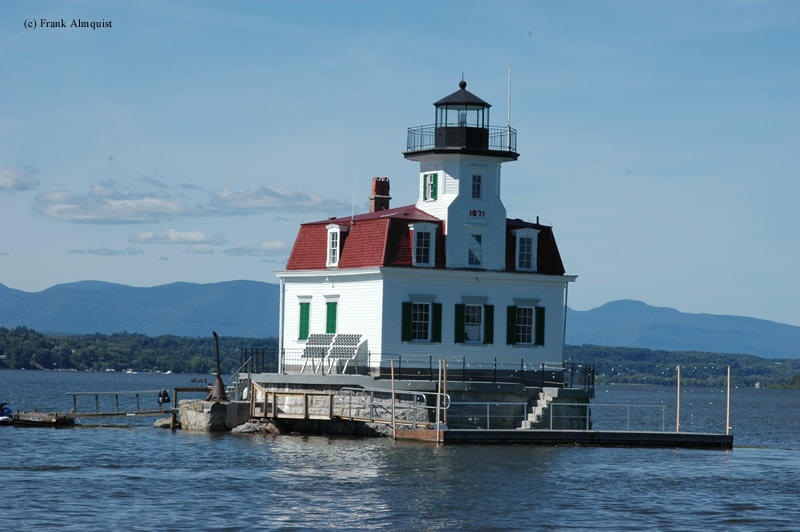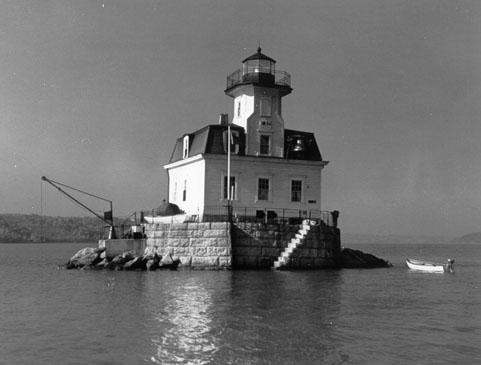Esopus Meadows Lighthouse
Esopus, New York - 1872 (1839**)

History of the Esopus Meadows Lighthouse
Posted/Updated by Bryan Penberthy on 2015-11-08.
The history of the Esopus Meadows Lighthouse, or the "Maid of the Meadows" as it is affectionately known, is no doubt tied to the Erie Canal and the vital link that it provided between New York City and the largely agricultural Midwest.
Opened in 1825, the Erie Canal ran between Buffalo and Albany, both in New York State. To get goods to New York City and the Atlantic Ocean, they would travel by boat down the Hudson River. This voyage of several hundred miles, coupled with heavy traffic could sometimes be perilous, which led to many navigational aids being established along the Hudson River.
Just south of Kingston, near the village of Port Ewen, there was a meadow where a local farmer, George Terpening, would bring his cattle to graze on water celery at low tide. Over time, the river rose and flooded the area. Depending on the tides, the meadow was covered by 12-18" of water.
Seeing the great expanse of water where the meadow once stood gave boat captains the impression that it was navigable. Many vessels became stranded on the submerged mud flats, some so large that they couldn't be pulled free at high tide. At a great expense, tugs were brought in to free them.
On March 3, 1831, Congress appropriated $3,000 for "erecting a beacon light at the junction of Rondout Creek and Hudson River, or on or near the Esopus Meadows, as may be deemed most expedient by the Secretary of the Treasury."
The funds allocated weren't enough to build either lighthouse. As nothing was done, the money reverted back to the Treasury. Congress appropriated $3,000 on March 3, 1837, however, the following year, it was noted that it was insufficient:
For the light house at Esopus meadows [sic], on the Hudson river [sic], three thousand dollars only were appropriated. It will require at least six thousand dollars, and, consequently, nothing has been done in relation to it. The proper sites [sic] is inundated at high tides, rendering it necessary to place the building on a pier so strong as to resist the floating ice in the spring of the year.
On July 7, 1839, Congress appropriated an additional $3,000 to adequately fund the building of the Esopus Meadows Lighthouse. The selected location for the lighthouse was the mud flat where George Terpening's cows once grazed. He sold the property to the United States Government for $1.00.
The first lighthouse at Esopus was a thirty-four by twenty-foot stone keeper's dwelling. On its roof was a four-foot tower outfitted with four lamps and reflectors. That stood atop a forty-one by fifty-foot wooden pier, standing nine feet above the mud flat.
The northern side of the pier was triangular in shape to act as an icebreaker for ice floating down the river. The southern side, however, was unprotected. With a southeast wind and high tides, ice would be driven into the pier. By 1857, a triangular extension was built on the south side as well.
When the Lighthouse Board claimed oversight of navigational aids in 1852, they began outfitting all lighthouses with Fresnel lenses. In 1854, the station's lamp and reflectors were removed and replaced with a sixth-order Fresnel lens.
Its exposed location in the middle of the Hudson River left it vulnerable to the elements. By the 1867, it was showing up in government reports as being in "ruinous condition," and it was recommended to rebuild the station. The same sentiments were echoed in the following year.
A more urgent request appeared in the Report of the Secretary of the Treasury on the State of the Finances for the year 1869. It is presented below:
165. Esopus Meadows, Hudson River, N.Y. - As reported in the two annual reports, this station is in an exceeding bad state, and only economical remedy is to rebuild the light-house. The wooden pier upon which this light house [sic] stands is in such a delapidated [sic] state that is feared the whole will be taken away by the ice and freshets the coming winter. The keeper's house is unfit for occupancy in winter, even if the foundation pier were safe enough to justify its occupancy. An estimate for the construction of a light station similar to those recently built at different points on the Hudson River is submitted in the annual estimates.
An appropriation of $25,000 was made on July 15, 1870 for rebuilding the tower and dwelling. However, the Lighthouse Board felt that they didn't have adequate enough time to get the lighthouse to point where it would be protected from winter storms, so the decision was made to wait until spring of 1871 to start its construction.
 Esopus Meadows Lighthouse (courtesy Coast Guard)
Esopus Meadows Lighthouse (courtesy Coast Guard)
A new pier of rock-faced granite was built a short distance from the original lighthouse. To build the pier, 250 piles, each forty feet long, were driven into the river bottom and cut off three feet below the mean water line. The piles were then capped with 12-inch square timbers and topped with a deck of 3-inch pine.
To construct the pier, granite blocks were stacked 16 feet high, tapering from a 49-foot diameter to a 46-foot diameter. Atop the pier, a wood-framed keeper's dwelling with mansard roof and clapboard siding, was constructed. On the first floor were a kitchen, equipment room, and sitting room. The second floor featured bedrooms, a bathroom, and access to the tower.
The design was similar to Rose Island Lighthouse or the Pomham Rocks Lighthouse, both in Rhode Island.
When the lighthouse was completed in 1872, the sixth-order Fresnel lens installed in original tower in 1854 was placed into storage and the new tower received a larger fifth-order lens. The light was exhibited from the new tower for the first time on august 26, 1872 and was visible for 12 nautical miles. The following year, the original lighthouse was torn down.
A fog bell operated by machinery was established at the station for the start of the navigation season in 1891.
Although the station was better protected by the granite pier, it was still exposed to the elements. In 1903, a tow and tug struck the northeast corner of the dwelling, causing considerable damage. Six years later, the same location was struck by an ice barge that broke away. The incident caused extensive damage to the foundation, deck, and railing.
Barges and boats weren't the only things to stike the Esopus Meadows Lighthouse, it was still affected by ice floes. The night of December 22, 1929, a large field of ice was drifting down the Hudson River and struck the lighthouse, shaking it.
Keeper Andrew McLintock reported "I have not been able to leave the station long enough to go to Kingston for food since December 6th. I have a good supply of ordinary food, but it is impossible to keep such perishable necessities as yeast, meat and butter on the station. And I cannot get ashore unless a west or northwest gale blows the tide down two feet or more below the normal low tide mark. Then I have to walk through the mud as I did on the 19th of December."
His report garnered very little sympathy from the Third District office. They stated that the conditions were nothing new for the station and that the Esopus Meadows Lighthouse, like many others in the district, were affected by ice and were in need of additional riprap.
The following year, protection would come when several tons a riprap were delivered at a cost of $6,850.
On August 14, 1965, the Coast Guard automated the Esopus Meadows Lighthouse, replacing it with a twenty-six-foot skeletal tower in 1974. Five years later, the lighthouse was added to the National Register of Historic Places.
When the station was automated, the windows were boarded up. To give a "lived-in" look, the boards were painted to look like curtained windows in an attempt to discourage would-be vandals. Although it seemed like a good idea, it didn't work.Even though the station stood offshore and was only accessible by boat, vandals still struck. Influences from other elements, such as Mother Nature, the forces of the river, and collisions with barges left the Esopus Meadows Lighthouse battered and timeworn.
During this time, there was extensive settling and separation on the northeast side of the granite pier, which was the site of the previous collisions. This led to a nearly 16" list on the east side of the lighthouse. In 1986, concerned volunteers organized under the direction of Arline Fitzpatrick, a niece of a former keeper.
The group leased the lighthouse from the Coast Guard, allowing them to start the restoration process. They started with repairing the damaged interior, painting the exterior, and replacing the windows and roof. Over time, one by one, people began to drop out and by the mid-1990s, Arline Fitzpatrick was the only one left.
As the station's foundation was still failing and it was leaning, the Coast Guard had scheduled the lighthouse for demolition. In 1997, Pat Ralston took over leadership and put an article in the local paper looking for volunteers, thus forming the Save Esopus Lighthouse Commission. Some of the new volunteers were from the Coast Guard Aids to Navigation station in nearby Saugerties.
By the fall of 2000, the lighthouse was leveled and stabilized, removing the noticeable lean. In July of 2001, the restoration was reorganized as a museum under the New York State Board of Regents, providing a provisional charter as the Esopus Meadows Lighthouse. This allowed the group to seek additional funding and ownership of the lighthouse.
On September 22, 2002, the general Services Administration, under the National Historic Lighthouse Preservation Act of 2002 pilot disposal program formally granted stewardship of the lighthouse to the newly chartered Esopus Meadows Lighthouse.
A new light was installed in the lantern in May of 2003. Stan Fletcher, the keeper that had extinguished the light when the station was automated in 1965, was the man to relight the beacon, ending 38 years of darkness.
Over the years, the group has continued the restoration. The list includes a new deep water dock, plumbing, painting, new lights, and flooring. All this work allowed the group to open the lighthouse to tours each year.
Reference:
- Northeast Lights - Lighthouses and Lightships, Robert G. Bachand, 1989.
- Annual Report of the Light House Board, U.S. Lighthouse Service, Various years.
- Various Government Documents, Federal & State Governments, Various dates.
- "Maid of the Meadows - A Promise Kept," Pat Ralston, Lighthouse Digest, July / August 2012.
- "Esopus Lighthouse - Final Chance for Survival," Staff, Lighthouse Digest, December 1997.
- "Darkened Beacon Relit," Staff, Lighthouse Digest, August 2003.
- esopusmeadowslighthouse.org website.
- "Women of the Light," Jeremy D'Entremont, Lighthouse Digest, December 2002.
Directions: The lighthouse sits out in the Hudson River, so therefore the best views are from the water. Distant views are possible from the Esopus Meadows Preserve or from the Lighthouse Park, both of which are on River Road / County Road 24, just off Route 9W south of Kingston.
Accesss: The lighthouse is owned by the Save Esopus Lighthouse Committee. The lighthouse is open for tours.
View more Esopus Meadows Lighthouse picturesTower Height: 55.00'
Focal Plane: 58'
Active Aid to Navigation: Deactivated (1965)
*Latitude: 41.86800 N
*Longitude: -73.94200 W
See this lighthouse on Google Maps.
